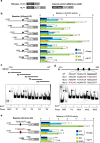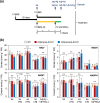Arabidopsis nitrate-induced aspartate oxidase gene expression is necessary to maintain metabolic balance under nitrogen nutrient fluctuation
- PMID: 35534536
- PMCID: PMC9085827
- DOI: 10.1038/s42003-022-03399-5
Arabidopsis nitrate-induced aspartate oxidase gene expression is necessary to maintain metabolic balance under nitrogen nutrient fluctuation
Abstract
Nitrate is a nutrient signal that regulates growth and development through NLP transcription factors in plants. Here we identify the L-aspartate oxidase gene (AO) necessary for de novo NAD+ biosynthesis as an NLP target in Arabidopsis. We investigated the physiological significance of nitrate-induced AO expression by expressing AO under the control of the mutant AO promoter lacking the NLP-binding site in the ao mutant. Despite morphological changes and severe reductions in fresh weight, the loss of nitrate-induced AO expression resulted in minimum effects on NAD(H) and NADP(H) contents, suggesting compensation of decreased de novo NAD+ biosynthesis by reducing the growth rate. Furthermore, metabolite profiling and transcriptome analysis revealed that the loss of nitrate-induced AO expression causes pronounced impacts on contents of TCA cycle- and urea cycle-related metabolites, gene expression profile, and their modifications in response to changes in the nitrogen nutrient condition. These results suggest that proper maintenance of metabolic balance requires the coordinated regulation of multiple metabolic pathways by NLP-mediated nitrate signaling in plants.
© 2022. The Author(s).
Conflict of interest statement
The authors declare no competing interests.
Figures









Similar articles
-
Discovery of nitrate-CPK-NLP signalling in central nutrient-growth networks.Nature. 2017 May 18;545(7654):311-316. doi: 10.1038/nature22077. Epub 2017 May 10. Nature. 2017. PMID: 28489820 Free PMC article.
-
Direct transcriptional activation of BT genes by NLP transcription factors is a key component of the nitrate response in Arabidopsis.Biochem Biophys Res Commun. 2017 Jan 29;483(1):380-386. doi: 10.1016/j.bbrc.2016.12.135. Epub 2016 Dec 23. Biochem Biophys Res Commun. 2017. PMID: 28025145
-
Nitrate-responsive NIN-like protein transcription factors perform unique and redundant roles in Arabidopsis.J Exp Bot. 2021 Jul 28;72(15):5735-5750. doi: 10.1093/jxb/erab246. J Exp Bot. 2021. PMID: 34050740
-
Transcriptional networks in the nitrate response of Arabidopsis thaliana.Curr Opin Plant Biol. 2015 Oct;27:125-32. doi: 10.1016/j.pbi.2015.06.010. Epub 2015 Aug 3. Curr Opin Plant Biol. 2015. PMID: 26247122 Review.
-
Interactions between nitrogen and cytokinin in the regulation of metabolism and development.Trends Plant Sci. 2006 Sep;11(9):440-8. doi: 10.1016/j.tplants.2006.07.004. Epub 2006 Aug 8. Trends Plant Sci. 2006. PMID: 16899391 Review.
Cited by
-
Characterization key genes of Arabidopsis seedlings in response to β-caryophyllene, eugenol using combined transcriptome and WGCN analysis.Front Plant Sci. 2024 Jan 4;14:1295779. doi: 10.3389/fpls.2023.1295779. eCollection 2023. Front Plant Sci. 2024. PMID: 38239209 Free PMC article.
-
Enhanced Natamycin production in Streptomyces gilvosporeus through phosphate tolerance screening and transcriptome-based analysis of high-yielding mechanisms.Microb Cell Fact. 2025 Apr 2;24(1):79. doi: 10.1186/s12934-025-02696-y. Microb Cell Fact. 2025. PMID: 40176084 Free PMC article.
-
The Arabidopsis transcription factor NLP2 regulates early nitrate responses and integrates nitrate assimilation with energy and carbon skeleton supply.Plant Cell. 2023 Apr 20;35(5):1429-1454. doi: 10.1093/plcell/koad025. Plant Cell. 2023. PMID: 36752317 Free PMC article.
References
-
- Campbell WH. Nitrate reductase and its role in nitrate assimilation in plants. Physiol. Plant. 1988;74:214–219. doi: 10.1111/j.1399-3054.1988.tb04965.x. - DOI
-
- Scheible W-R, Lauerer M, Schulze E-D, Caboche M, Stitt M. Accumulation of nitrate in the shoot acts as a signal to regulate shoot-root allocation in tobacco. Plant J. 1997;11:671–691. doi: 10.1046/j.1365-313X.1997.11040671.x. - DOI
Publication types
MeSH terms
Substances
LinkOut - more resources
Full Text Sources
Molecular Biology Databases

